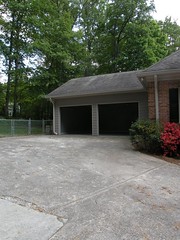
Image via Wikipedia
Millions of American families are facing foreclosure. Millions more have already been through the process… and there are millions that don’t know it yet, but they will be staring at foreclosure proceedings in the future. It is an epidemic, one that is difficult to escape. Not impossible… but difficult.
Foreclosures are accelerating for a couple of reasons… but one of them is momentum. As a neighborhood faces foreclosures, the values of the non-foreclosed homes dwindles. Foreclosures generally bring lower prices, which pushes down the prices of non-foreclosed homes… which pushes down the prices of the foreclosures. It is a self-perpetuating cycle. Buyers are afraid to jump in because they see prices still moving down. Sellers get desperate to get out because they see their equity (if they have any) drying up. The cycle continues. Some of the people that needed to move couldn’t hack the values anymore, and they let their home slide into foreclosure.
Those that are marginal or that trying to be proactive call their banks. They talk with them about short sales or loan modification. For the vast majority seeking a loan modification (we are talking 98%+ here), they might as well talk to a brick wall. Short sales are slightly more common, assuming the seller only has one mortgage.
Banks simply aren’t really open to talking with the homeowners about their situation. And there are a variety of reasons. Some of them they are willing to say (in an unguarded moment, perhaps). Other reasons the people in the Loss Mitigation department might not even realize… if they do, they aren’t talking.
And the big one that nobody seems to talk about…
- The banks insurance on the loan will cover them in a default, limiting the amount of loss they will suffer. However, if they modify or allow a short sale, their insurance won’t kick in. That increases their loss.
This is the one that really needs to be worked on. The insurance company… the people that REALLY need to be involved in loss mitigation, don’t have a seat at the table. And the big losses are at the loan insurance level. Whether it is a private insurer like AIG (remember their bailout?), a government sponsored entity like Freddie Mac or Fannie Mae or a public loan guarantor HUD, they don’t have the chance to be actively involved in the process until it is too late.
To Fix it…
The first thing that would need to happen is for the entity that insures of guarantees the loan to have an active role in the decision about modification or foreclosure. Right now, in the case of a short sale, it is up to the “investors”, those that actually own the loan (often that is NOT the bank).
When a homeowner inquires about a loan modification, the bank should do their best to determine two things… they should look at the value of the property and the homeowner’s ability to pay. What they should be looking for is to find at what level the homeowner would likely be able to pay. At that point, the insurance company (or loan guarantor) should take over if the numbers look like they would be bearing the loss.

Image via Wikipedia
Example:
- Bob the homeowner loses his job and ends up working for less money. He can no longer really afford his home, but doesn’t want to walk away. He paid $300,000 for the house and owes $285,000.
- Bob contacts his bank. The bank determines that the house would likely sell in a foreclosure sale for $210,000. Bob would be able to qualify for a loan of $220,000. The banks insurance kicks in at $240,000.
- At this point, the insurer would review the file. If the bank takes the house, they would have to pay the bank whatever loss they suffered under $240,000.
- Rather than the bank going through with foreclosure, the insurance company agrees to pay $30,000 if they re-write Bob’s loan to $215,000.
Bob ends up owing a little more than the house might fetch in a foreclosure sale. The bank doesn’t incur the costs of foreclosing and having to get the property ready for sale. The insurance company takes a hit, but it might be a smaller hit than they would have taken had the house been foreclosed. And there is less risk for everyone involved.

Image by epSos.de via Flickr
Of course, the example above is completely fictitious. The numbers are pulled out of thin air… And honestly, there are a LOT of people that would not be helped in such a situation. The goal, however, isn’t to save every homeowner in the country that is upside-down. The goal is to minimize losses to consumers, the banks, insurance companies, GSEs and the government, while helping people that still have some capacity to participate.
People without income or expenses too high to make a reasonable payment are not going to be helped. People that take advantage of the system once and are trying to get a third chance would likely not be helped (I would call a program like this a good second chance).











